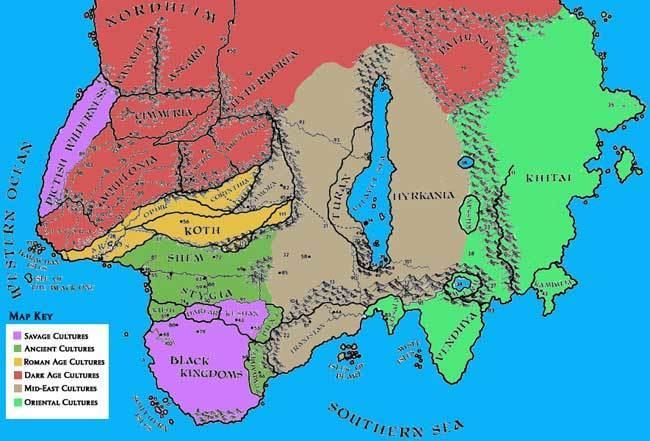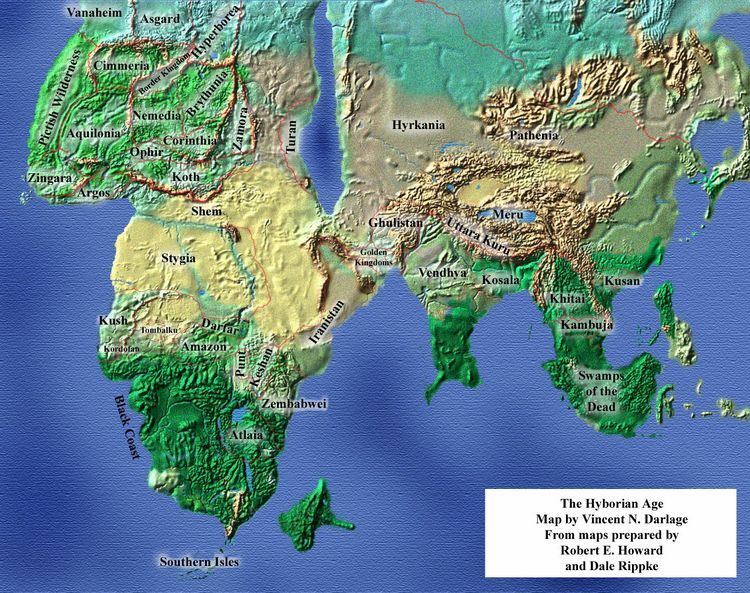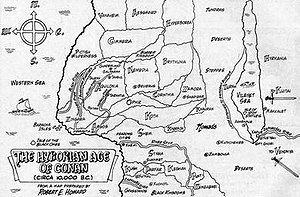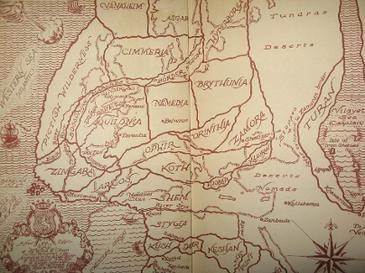 | ||
Conan s hyborian age beginnings part 1
The Hyborian Age is a fictional period within the artificial mythology created by Robert E. Howard, in which the sword and sorcery tales of Conan the Barbarian are set.
Contents
- Conan s hyborian age beginnings part 1
- Cataclysmic ancestors
- Hyborian ancestors
- Beginnings of the Hyborian Age
- Rulers of the West
- The world
- Etymology
- References

The word "Hyborian" is derived from the legendary northern land of the ancient Greeks, Hyperborea, and is rendered as such in the earliest draft of Howard's essay "The Hyborian Age." Howard described the Hyborian Age taking place sometime after the sinking of Atlantis and before the beginning of recorded Ancient history. Most later editors and adaptors such as L. Sprague de Camp and Roy Thomas placed the Hyborian Age around 10,000 BCE. More recently, Dale Rippke proposed that the Hyborian Age should be placed further in the past, around 32,500 BCE, prior to the beginning of the last glacial period. Rippke's date, however, has since been disputed by Jeffrey Shanks who argues for the more traditional placement at the end of the ice age.

Howard had an intense love for history and historical dramas; however, at the same time, he recognized the difficulties and the time-consuming research needed in maintaining historical accuracy. By conceiving a timeless setting – a vanished age – and by carefully choosing names that resembled our history, Howard avoided the problem of historical anachronisms and the need for lengthy exposition.

Cataclysmic ancestors
Howard explained the origins and history of the Hyborian civilization in his essay "The Hyborian Age." The essay begins with the civilizations of the Thurian Age, Lemuria, and Atlantis, mentioned in his series about Kull, being destroyed by a cataclysm.
According to the essay, after this cataclysm, a group of primitive humans were at a technological level hardly above the Neanderthal. They fled to the northern areas of what was left of the Thurian continent to escape the destruction. They discovered the areas to be safe but covered with snow and already inhabited by a race of vicious apes. The apes were large with white fur and apparently native to their land. The Stone Age invaders engaged in a territorial war with them and eventually managed to drive them off, past the Arctic Circle. Believing their enemies fated to perish and no longer interested in them, the recently arrived group adapted to their new, harsh environment and its population started to increase.
Hyborian ancestors
One thousand five hundred years later, the descendants of this initial group were called "Hyborians". They were named after their highest ranking god deity, Bori. The essay mentions that Bori had actually been a great tribal chief of their past who had undergone deification. Their oral tradition remembered him as their leader during their initial migration to the north though the antiquity of this man had been exaggerated.
By this point, the various related but independent Hyborian tribes had spread throughout the northern regions of their area of the world. Some of them were already migrating south at a "leisurely" pace in search of new areas in which to settle. The Hyborians had yet to encounter other cultural groups, but engaged in wars against each other. Howard describes them as a powerful and warlike race with the average individual being tall, tawny-haired, and gray-eyed. Culturally, they were already accomplished artists and poets. Most of the tribes still relied on hunting for their nourishment. Their southern offshoots, however, had been practicing animal husbandry on cattle for a number of centuries.
The only exception to their long isolation from other cultural groups came due to the actions of a lone adventurer, unnamed in the essay. He had traveled past the Arctic Circle and returned with news that their old adversaries, the apes, were not in fact annihilated. They had instead evolved into apemen and according to his description were by then numerous. He believed they were quickly evolving to human status and would pose a threat to the Hyborians in the future. He attempted to recruit a significant military force to campaign against them, but most Hyborians were not convinced by his tales and at last only a small group of foolhardy youths followed his campaign. None of them returned.
Beginnings of the Hyborian Age
With the population of the Hyborian tribes continuing to increase, the need for new lands also increased. The Hyborians started expanding outside their familiar territories, beginning a new age of wanderings and conquests. For five hundred years, the Hyborians spread towards the south and the west of their nameless continent.
They encountered other tribal groups for the first time in millennia. They conquered many smaller clans of various origins. The survivors of the defeated clans merged with their conquerors, passing on their racial traits to new generations of Hyborians. The mixed-blooded Hyborian tribes were in turn forced to defend their new territories from pure-blooded Hyborian tribes which followed the same paths of migration. Often, the new invaders would wipe away the defenders before absorbing them, resulting in a tangled web of Hyborian tribes and nations with varying ancestral elements within their bloodlines.
The first organized Hyborian kingdom to emerge was Hyperborea. The tribe that established it entered their Neolithic age by learning to erect buildings in stone, largely for fortification. These nomads lived in tents made out of the hides of horses, but soon abandoned them in favor of their first crude but durable stone houses. They permanently settled in fortified settlements and developed cyclopean masonry to further fortify their defensive walls.
The Hyperboreans were by then the most advanced of the Hyborian tribes and set out to expand their kingdom by attacking their backwards neighbors. Tribes who defended their territories lost them and were forced to migrate elsewhere. Others fled the path of Hyperborean expansion before ever engaging them in war. Meanwhile, the "apemen" of the Arctic Circle emerged as a new race of light-haired and tall humans. They started their own migration to the south, displacing the northernmost of the Hyborian tribes.
Rulers of the West
For the next thousand years, the warlike Hyborian nations advanced to become the rulers of the western areas of the nameless continent. They encountered the Picts and forced them to limit themselves to the western wastelands, which would come to be known as the "Pictish Wilderness". Following the example of their Hyperborean cousins, other Hyborians started to settle down and create their own kingdoms.
The southernmost of the early kingdoms was Koth, which was established north of the lands of Shem and soon started extending its cultural influence over the southern shepherds. Just south of the Pictish Wilderness was the fertile valley known as "Zing". The wandering Hyborian tribe which conquered them found other people already settled there. They included a nameless farming nation related to the people of the Shem and a warlike Pictish tribe who had previously conquered them. They established the kingdom of Zingara and absorbed the defeated elements into their tribe. Hyborians, Picts, and the unnamed kin of the Shemites would merge into a nation calling themselves Zingarans.
On the other hand, at the north of the continent, the fair-haired invaders from the Arctic Circle had grown in numbers and power. They continued their expansion south while in turn displacing defeated Hyborians to the south. Even Hyperborea was conquered by one of these barbarian tribes. But the conquerors here decided to maintain the kingdom with its old name, merged with the defeated Hyperboreans and adopted elements of Hyborian culture. The continuing wars and migrations would keep the state of the other areas of the continent for another five hundred years.
The world
The Hyborian Age was devised by author Robert E. Howard as the post-Atlantean setting of his Conan the Cimmerian stories, designed to fit in with Howard's previous and lesser known tales of Kull, which were set in the Thurian Age at the time of Atlantis. The name "Hyborian" is a contraction of the Greek concept of the land of "Hyperborea", literally "Beyond the North Wind". This was a mythical place far to the north that was not cold and where things did not age.
Howard's Hyborian epoch, described in his essay The Hyborian Age, is a mythical time before any civilization known to anthropologists. Its setting is prehistoric Europe and North Africa (with occasional references to Asia and other continents).
On a map Howard drew conceptualizing the Hyborian Age, his vision of the Mediterranean Sea is dry. The Nile, which he renamed the River Styx, takes a westward turn at right angles just beyond the Nile Delta, plowing through the mountains so as to be able to reach the Straits of Gibraltar. Although his Black Sea is also dry, his Caspian Sea, which he renames the Vilayet Sea, extends northward to reach the Arctic Ocean, so as to provide a barrier to encapsulate the settings of his stories. Not only are his Baltic Sea and English Channel dry, but most of the North Sea and a vast region to the west, easily including Ireland, are, too. Meanwhile, the west coast of Africa on his map lies beneath the sea.
Etymology
In his fantasy setting of the Hyborian Age, Howard created imaginary kingdoms to which he gave names from a variety of mythological and historical sources. Khitai is his version of China, lying far to the east, Corinthia is his name for a Hellenistic civilization, a name derived from the city of Corinth and reminiscent of the imperial fiefdom of Carinthia in the Middle Ages. Howard imagines the Hyborian Picts to occupy a large area to the northwest. The probable intended analogues are listed below; notice that the analogues are sometimes very generalized, and are portrayed by ahistorical stereotypes. Most of these correspondences are drawn from "Hyborian Names", an appendix to Conan the Swordsman by L. Sprague de Camp and Lin Carter.
